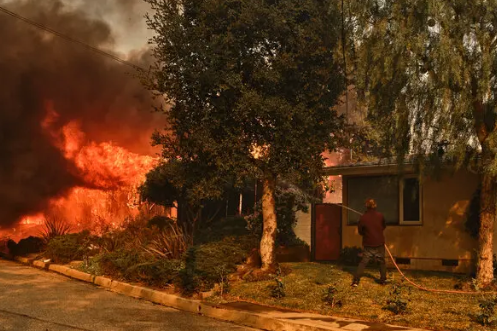By Snigdha Chakravarti
On January 7, 2025 at 10:20am, the Palisades fire began its trek along destroying thousands of acres of southern California. A red flag warning was issued for LA and Ventura counties when the Palisades fire was first viewed, and at noon, evacuation orders began. Governor Gain Newsom declared a state of emergency as the Palisades fire grew to 1200 acres in a single day. Soon after, the Palisades’s destruction of southern California was joined by the Eaton fire at 6:18pm on the same day, resulting in evacuation orders in Eaton’s origin, Altadena county. The California wildfires had only just begun and would be the worst in the history of wildfires in Los Angeles.
The wildfires in Los Angeles had occurred primarily due to drought and strong Santa Ana winds, thus allowing the fire to spread through “flammable vegetation.” In fact, in Mountain Lukens, which was exposed to the Eaton fire, wind gusts reached 100 miles per hour. By January 8th, the Lidia fire emerged in Acton county, and the Sunset fire started up in Hollywood Hills, all while the Palisades and Eaton fires spread 3000 and 1000 acres, respectively. On January 9th, then-President Biden declared that the national government will deal with 100% (up from the usual 75%) of the costs spawning from the “catastrophic” fire for 180 days. The president stated how the federal funding would go to cleaning up debris, putting up shelters, and sending 400 federal firefighters and 30 federal firefighting planes. Additionally, the president mentioned how the Congress needed to “step up” and “spare no expense” in order to pass the federal funding for rebuilding efforts. By this time, the Palisades fire had spread 17,000 acres and the Eaton fire, 10,000 acres.
At around 4pm on January 9th, an evacuation alert was accidently sent to ten million residents of Los Angeles County; the evacuation alert was meant for people in and around West Hills, who were in danger from the newly formed Kenneth Fire. Due to this, the Office of Emergency Services would take care of evacuation alerts. According to County Supervisor Janice Hahn, the evacuation warning was “mistakenly issued countywide due to a technical error.” Later, Kevin McGowan, the director of the Los Angeles County Office of Emergency Management explained how the warning was “intended only for residents of Calabasas and Agoura Hills and those within the West Hills community of Los Angeles”, but the Office of Emergency Management was “committed to sharing accurate information”, realizing that “these wildfires have created great anxiety, hardship, and distress among our residents.”
On January 10th, a new fire started in Granada Hills, while the Palisades and Eaton fires had spread 20,000 and 14,000 acres, respectively. Governor Newsom launched an independent investigation concerning the close of the Pacific Palisades Reservoir prior to the start of the Palisades fire, namely the “the reported unavailability of water supplies.” However, for other places in southern California, water contamination seems to be a major issue. In Pasadena, for example, residents are not allowed to drink water. Water contamination is primarily caused by the water source or the system delivering it. In many cases of the current wildfires in California, there are issues with the system delivering the water. As a result of high water usage by firefighters, depressurization occurred, thus resulting in a vacuum. This vacuum, according to Jackson Webster, a professor of civil engineering at California State University in Chico, “pulls contaminants, like gases from combustion, back into the distribution system. And this causes chemical contamination of the distribution system which is very difficult to get rid of.” Such chemical contaminants include carcinogenic chemicals like benzene, which was found in water after the 2017 Tubbs Fire and 2018 Camp Fire. Soot from damaged structures can also enter broken pipes and tank vents, furthermore contaminating the water.
By January 21st, 28 people were dead while 18 were missing. The Eaton fire was deemed the deadliest fire in Los Angeles history with 17 deaths. However, both the Palisades and Eaton fires were contained, 65% and 89%, respectively. A whopping 15,000 structures were destroyed as a result of the fires.
On Wednesday, January 22, the Hughes fire broke out, spreading 500 acres in just one hour and eventually making its way through 10,000 acres. 31,000 people were evacuated and 23,000 were given warnings. These evacuees included students from Castaic Middle and High School, who were evacuated to a supermarket parking lot, students from Castaic Elementary, who were evacuated to a sports complex, and 4500 inmates from the Pitchess Detention Center. Additionally, aircraft dropped 30,000 gallons of fire retardant and 113,00 gallons of water to keep the fire spreading to surrounding communities. By Friday morning, the fire was 36% contained.

